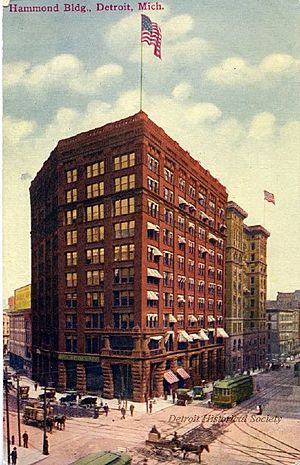Hammond Building facts for kids
Quick facts for kids Hammond Building |
|
|---|---|

c.1900
|
|
| General information | |
| Status | Demolished |
| Type | Commercial offices |
| Location | 632-656 Griswold Street Detroit, Michigan |
| Coordinates | 42°19′50″N 83°02′50″W / 42.3306°N 83.0471°W |
| Completed | 1889 |
| Demolished | 1956 |
| Height | |
| Roof | 45.72 m (150.0 ft) |
| Technical details | |
| Floor count | 10 plus excavated basement |
| Design and construction | |
| Architect | George H. Edbrooke |
The Hammond Building was a tall building completed in 1889. It stood in downtown Detroit, Michigan, right across from the old Detroit City Hall. This building was 46 m (151 ft) tall.
It was designed by George H. Edbrooke and is known as Detroit's first skyscraper. When it was built, it was the tallest building in the entire state of Michigan. The Hammond Building was torn down in 1956. A new building, now called The Qube, was built in its place.
Contents
History
George H. Hammond: The Man Behind the Name
George H. Hammond was born in Massachusetts. He moved to Detroit in 1854 and started a small meat shop. He later bought a special invention: a refrigerated train car. This car used ice and salt to keep meat cold during long trips.
Hammond used these refrigerated cars to ship beef from Detroit all the way to Boston. This was a big deal because it meant fresh meat could travel far. He built a huge business, owning over 800 refrigerated cars. His company processed 100,000 cattle every year.
Hammond died in 1886. He left his money to his wife, Ellen Hammond. Ellen sold his meat business for over $2 million. George had planned to build a skyscraper before he died. After his death, Ellen bought the land for $350,000 and had the building constructed. It was finished in 1889.
Building the Skyscraper
Construction of the Hammond Building started on March 14, 1889. First, old buildings on the site were torn down. This included the home of Detroit's first postmaster, James Abbott.
The building was made with strong iron beams and wooden floors. The outside walls were built with red bricks and stone. Inside, the office floors were made of oak wood. The hallways had marble floors and marble walls.
Sometimes, construction would stop because there weren't enough mules to help with the work!
Ellen Hammond hired an architect named George H. Edbrooke. She held back 15% of his payment to make sure the work was good. But after the building was done, some parts, like the plastering and heating, were not perfect. Because of this, Edbrooke wasn't paid all his money. He then couldn't pay some of the companies that worked for him.
How the Building Was Used
In August 1890, the building's 246 offices were lit up for a whole week. This was to celebrate the Detroit International Exposition. They used both electric lights and gas lights to make the building shine. During the day, people could visit and tour the offices.
The roof of the building was used for an important job. Signals were sent from the roof to ships on the Detroit River. These signals warned them about storms on the Great Lakes.
Over the years, many different businesses had offices in the Hammond Building. In 1911, the Dime Savings Bank was a tenant. The United States Department of Agriculture also had offices there.
The Building's End
By 1944, it was becoming expensive to run the Hammond Building. Newer, more modern tall buildings had been built in Detroit. The Hammond Building was not making much money from rentals.
The company that owned the building closed down on February 15, 1956.
Later in 1956, the Hammond Building was torn down. This was to make space for a new headquarters building for the National Bank of Detroit. Construction on the new building started in 1957. The bank moved into its new home in September 1959. Today, that building is owned by Quicken Loans and is known as The Qube.
^ a: Some records say Harry W.J. Edbrooke was the architect. However, he finished architecture school in 1898, which was after the Hammond Building was already built.
See also
 In Spanish: Hammond Building para niños
In Spanish: Hammond Building para niños


